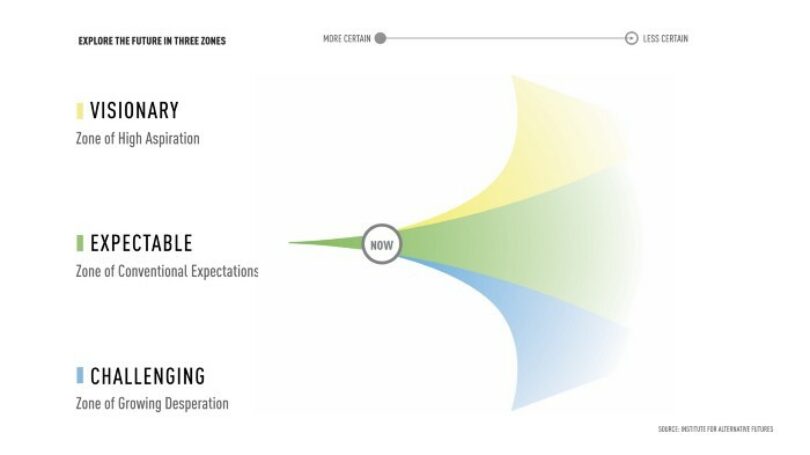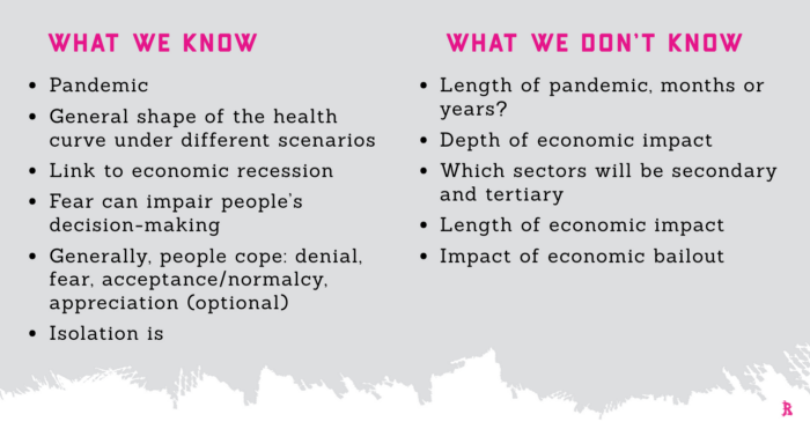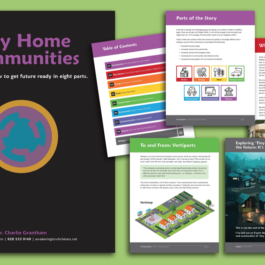What are the top 10 trends for the next ten years? Download the report here.

When you have no idea what your future will be, how can you plan? Here’s a 6-step process to get clear and get ready.
1. Start with what you know
It’s Tuesday, March 24. Right now on a macro scale we know:
- Coronavirus is a global pandemic. Communities that don’t take immediate action to limit the contagion are (inadvertently?) lengthening the public health impact. (see March 19 briefing notes)
- Most of the United States is in pre-crisis mode. Here in Madison, Wisconsin for example, we expect our “peak” in hospitalizations around Saturday, April 11.
- The shape of the pandemic’s peak and decay from countries like China, South Korea, and Italy can help guide our plans and expectations.
- The pandemic will be linked to a recession.
- Fear impairs people’s decision-making.
- People are creative and resilient.
- People cope with change in predictable stages: denial; fear; acceptance of a ”new normal”; appreciation (optional)
What about you? As you think about your domain, what do you know?
2. Now ask, “What don’t we know?”
As of this writing, we don’t know:
- How long the pandemic will last — locally, nationally, or internationally.
- How long or deep the economic after-effects will last. This may be location-dependent, e.g. if you live in a community with an economy driven primarily by travel and tourism, your recovery may take longer.
- How the pandemic will impact the 2020 US presidential election
- The long term social impacts, e.g. how people will re-emerge after being in “shelter at home” conditions? Will people experience PTSD, and continue to isolate themselves? Will we ever be “back to normal?”
What about you? As you think about your domain, what don’t you know?

List of What we Know and What we Don’t Know, from March 18 webcast.
3. Track and update your lists
Over time, your list of “What we know” will lengthen and your list of “What we don’t know” will change. If you’re the leader of a team or a community, I strongly recommend that you track and discuss these lists, so your planning reflects changing conditions.
4. Explore the future in three zones
Thanks to the Institute for Alternative Futures, we can think of the future in three zones: Challenging; Expectable; and Visionary/Surprisingly successful:

A. The Challenging Future (the blue zone): Thinking about your domain, imagine a future in the “Zone of Growing Desperation:”
- What external events could occur that would worsen the situation?
- What missteps might you or other take, that could deepen your desperation?
- What else could occur, that would make the future feel more dire?
I recommend imagining this zone, the worst case scenario, first.
Why?
Doing the worst case scenario first honors people’s natural tendencies to worry during times of upheaval and anxiety. I call this “Zombie Apocalypse thinking.” Most people do this, and it’s important to give it a voice because it relieves people’s anxiety (temporarily) and allows you to share what’s on your mind, about a worst case scenario.
As a bonus: when people express their fears aloud without shame or judgment, it gives them a sense of being seen and heard, which is important to developing relationships and social cohesion. And those are going to be important in the weeks and months to come.
B. The Expectable Future (the green zone): Thinking about your domain, imagine a future that falls within a zone of conventional expectations. For example:
- How did Congress, your state, your community, your donors, your employers, etc. react to the Great Recession? We can probably expect similar responses to our economic crisis.
- If your community has been through a hurricane, F5 tornado, flood, fires or other devastating natural disasters, you’ve been through emergencies in the past and can probably expect similar coordination and responses now.
- What else could occur in the zone of conventional expectations?
At this point, after you’ve explored the “Zombie Apocolypse” and the “Expectatble” zone, you may start to feel a little better. But wait, there’s more.
C. The Visionary Future (the gold zone): Thinking about your domain, imagine a future in which more things go right than go wrong. For example:
- What if your community mounted an effective response and “flattened the curve?”
- What might federal, state, or local governments do that would be proactive and useful?
- What other external events could occur that would improve the situation?
- If residents were acting at their best, what could happen that would have near- and long-term positive impacts?
- What other plausible actions or events can you imagine that would have positive near-term and long-term effects?
Now, you’ve explored three plausible futures for your domain. Good work, there’s one more critical step to go.
5. Now ask , “What can we do now, to improve our future zone?”
All of us are, today, living in one of these zones. Which one are you in now? And what do you (or your company, organization, or community) need to do now to increase your chances of physical, financial, and social survival?
In every moment, we’re creating the conditions for our future. Choose wisely.
6. (Extra credit) Identify your trip wires
By now you’ve taken five steps to help you be more ready for what’s coming. But with rapidly changing conditions, there’s one more thing I recommend: identify your trip wires. Trip wires are thresholds that, when met, mean you’re confronting a new reality. For example, if you’ve just lost your job, that’s a major trip wire that might require new actions for a new reality.
Here’s a simple example:
Plan A: My current income remains the same and I live more or less like I always have.
Trip wire: I lose all or part of my income, tripping me into Plan B
Plan B: I cut all my expenses to the bone and begin living frugally from my emergency savings.
What about you? What trip wires will signal to you that you’re in a new reality, and you must adjust your plans or take bold action?
Thank you for reading. We’re in this together.
Scenario planning for anxious times, webinar:
If you enjoyed this post, please subscribe to our newsletter.

Rebecca Ryan, APF
Rebecca Ryan captains the ship. Trained as a futurist and an economist, Rebecca helps clients see what's coming - as a keynote speaker, a Futures Lab facilitator, an author of books, blogs and articles, a client advisor, and the founder of Futurist Camp. Check out her blog or watch her Q&A on how NGC helps organizations prepare for the future using Strategic Foresight. Contact Lisa Loniello for more information.
Yasemin Arikan Promoted to Director of Futures Research
NEXT Generation Consulting (NGC) announced the promotion of Yasemin Arikan to Director of Futures Research. Arikan will lead the company’s efforts to...
Is Your Housing Market Ready for Your Future?
One of the biggest problems facing many cities and towns is inadequate housing. This problem is most acute for seniors, veterans with disabilities, and low-income groups ...
Three Things Martha Stewart Gets Right About Return to Office (RTO)
The original influencer and the person who invented the "Home" retail category, Martha Stewart, became the latest CEO to tell employees to get back to the office five day...







